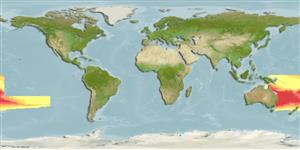>
Gadiformes (Cods) >
Moridae (Morid cods)
Etymology: Physiculus: Diminutive of Greek, physa = tube.
Environment: milieu / climate zone / depth range / distribution range
Ecología
marino batipelágico; rango de profundidad 83 - 610 m (Ref. 31777). Deep-water
Southwest Pacific: Australia, Bellona Plateau, New Caledonia, Kermadec Islands, New Zealand.
Tamaño / Peso / Age
Maturity: Lm ? range ? - ? cm
Max length : 16.8 cm SL macho / no sexado; (Ref. 31777)
A benthic species found on the continental shelf and slope (Ref. 75154).
Life cycle and mating behavior
Maturities | Reproducción | Spawnings | Egg(s) | Fecundities | Larva
Paulin, C.D. and C.D. Roberts, 1997. Review of the morid cods (Teleostei, Paracanthopterygii, Moridae) of New Caledonia, southwest Pacific Ocean, with description of a new species of Gadella. p. 17-41. In B. Séret (ed.) Résultats des Campagnes MUSORSTOM. Mem. Mus. Natl. Hist. Nat. (MMNHN), 174. (Ref. 31777)
IUCN Red List Status (Ref. 130435)
Threat to humans
Harmless
Human uses
Herramientas
Special reports
Download XML
Fuentes de Internet
Estimates based on models
Preferred temperature (Ref.
123201): 14.3 - 21.1, mean 18.7 °C (based on 32 cells).
Phylogenetic diversity index (Ref.
82804): PD
50 = 0.5000 [Uniqueness, from 0.5 = low to 2.0 = high].
Bayesian length-weight: a=0.01000 (0.00244 - 0.04107), b=3.04 (2.81 - 3.27), in cm total length, based on all LWR estimates for this body shape (Ref.
93245).
Nivel trófico (Ref.
69278): 3.4 ±0.4 se; based on size and trophs of closest relatives
Resiliencia (Ref.
120179): Medio, población duplicada en un tiempo mínimo de 1.4-4.4 años (Assuming tmax>3).
Fishing Vulnerability (Ref.
59153): Low vulnerability (11 of 100).
